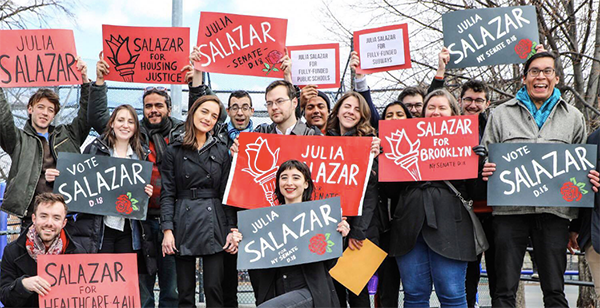
By A W
Julia Salazar’s victory was the product of our work today, but it is only the latest chapter in a long history of struggle by socialists (and others) in District 18. From rank-and-file worker organizing to elected officials to tenant groups acting in partnership with unions, Salazar’s victory is the latest instance of socialist activism in this corner of Brooklyn.
Workplace organizing and the fight for a shorter work day, weekends, and safety protections on the job were prominent features of late-19th and early-20th century America , and North Brooklyn was no exception. Williamsburg, Bushwick, and East New York formed a dense corridor of industrial manufacturing, as illustrated in this 1922 map.
The Brewery Workers’ Union is one example of labor organizing in the area, with many of the biggest breweries in New York located in Williamsburg and Bushwick. In 1881, a preventable fire from cask varnish killed four workers and sparked calls for a city-wide union of brewery workers. The union grew quickly, and with support from the Central Committee of the Socialist Labor Party, among other groups, its members went on strike for a 12-hour workday on weekdays (which included Saturday), a 2-hour break for meals, a 2-hour workday on Sundays, and higher wages. The workers returned after five weeks of striking, having failed to win their demands in that moment but having demonstrated the strength of their organizing power. But, by the next summer, the breweries had instated 12-hour workdays, and by 1888 the unionized workers were demanding 10-hour days.
The current boundaries of District 18 were drawn in 2012, but they overlap the old districts that previously sent socialist representatives to Albany. The first was Abraham I. Shiplacoff, who became the second Socialist Party politician ever sent to the Assembly when he was elected in 1915. His Kings County 23rd Assembly District, which overlapped the southwest corner of today’s District 18, included a large community of recent German immigrants living in Brownsville. Shiplacoff, an immigrant himself, fought for the rights of dairy workers to have a day off, and during the 1917 legislative session, introduced a bill to legalize the distribution of pamphlets describing methods of birth control. As the sole Socialist member of the Assembly, none of his bills passed. Despite Schiplacoff’s lack of success, the Socialist Party continued its rise, reaching in 1918 the height of its presence in Albany, with nine assembly members seated.
In 1919 the 23rd Assembly District was redrawn to cover parts of East New York that are now in the southeast corner of District 18. That year, the district again chose Socialist Party representation, electing Charles Solomon. At the very start of the session, however, the Republican leadership threw Solomon and four other members of the Socialist Party elected that year out, arguing that they were disloyal to the country because of their Socialist Party membership. All five were re-elected in the special elections called to replace them, but three were still not permitted to join the Assembly and so the other two resigned in protest. Solomon was re-elected in 1920, again on the Socialist Party line, and was finally allowed to take his seat.
In 1936 the American Labor Party split from the Socialist Party because the founders of the ALP did not want to work with the Communist Party or abandon electoral tactics. Between 1938 and 1948, the ALP represented parts of modern District 18 in Albany, with one Assemblyperson, one politician who served in both the Assembly and the Senate, and one Senator.
Along with its electoral work, the American Labor Party built strong connections to tenant organizers. Around 1940, there were residents of District 18 in the City-Wide Tenants Council, which was central in demanding federal price controls on rent. These tenants leagues, including a Williamsburg Tenants League that had been organizing since at least 1907, often used ALP offices as meeting spaces. In 1947, there was a rollback of the WWII-era federal rent controls, prompting massive outcry and tenant mobilization. The ALP and several unions, including the New York City Council of the CIO, supported the drive, which forced the governor to maintain some rent control at the state level. These controls evolved over the years into the dual layers of Rent Control and Rent Stabilization that we have today.
This is just a fraction of the rich history of socialism in North Brooklyn. It illustrates how socialists and others won protections not just by gaining representation in government, but by building networks of workers and tenants to hold all politicians accountable to serving their poor constituents. We in the DSA continue that struggle today, and Salazar’s election is another small step towards winning our demands for a New York that uses its wealth to allow all New Yorkers to have their needs met and dreams pursued.
If you are interested in telling more of the story of Socialist New York, please send your ideas to the Red Letter.
